Cypress is a common name for various coniferous trees or shrubs of northern temperate regions that belong to the family Cupressaceae. The word cypress is derived from Old French cipres, which was imported from Latin cypressus, the latinisation of the Greek κυπάρισσος (kyparissos). Cypress trees are a large classification of conifers, encompassing the trees and shrubs from the cypress family (Cupressaceae) and many others with the word cypress in their common name. Many cypress trees have needle-like, evergreen foliage and acorn-like seed cones.
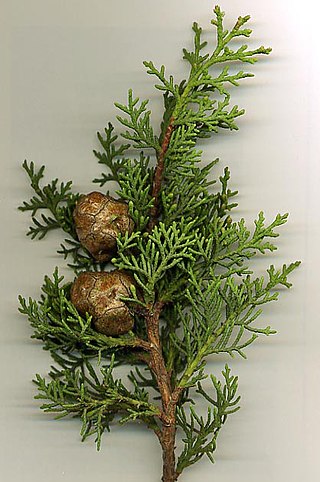
Cupressaceae is a conifer family, the cypress, with worldwide distribution. The family includes 27–30 genera, which include the junipers and redwoods, with about 130–140 species in total. They are monoecious, subdioecious or (rarely) dioecious trees and shrubs up to 116 m (381 ft) tall. The bark of mature trees is commonly orange- to red-brown and of stringy texture, often flaking or peeling in vertical strips, but smooth, scaly or hard and square-cracked in some species.
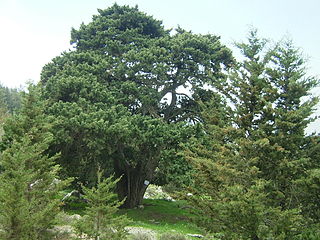
Cupressus is one of several genera of evergreen conifers within the family Cupressaceae that have the common name cypress; for the others, see cypress. It is considered a polyphyletic group. Based on genetic and morphological analysis, the genus Cupressus is found in the subfamily Cupressoideae. The common name "cypress" comes via the Old French cipres from the Latin cyparissus, which is the latinisation of the Greek κυπάρισσος (kypárissos).

Hesperocyparis macrocarpa also known as Cupressus macrocarpa, or the Monterey cypress is a coniferous tree, and is one of several species of cypress trees endemic to California.

The Leyland cypress, Cupressus × leylandii, X Cuprocyparis leylandii or X Cupressocyparis leylandii, often referred to simply as leylandii, is a fast-growing coniferous evergreen tree much used in horticulture, primarily for hedges and screens. Even on sites of relatively poor culture, plants have been known to grow to heights of 15 metres (49 ft) in 16 years. Their rapid, thick growth means they are sometimes used to achieve privacy, but such use can result in disputes with neighbours whose own property becomes overshadowed. The tree is a hybrid of Monterey cypress and Nootka cypress. It is almost always sterile, and is propagated mainly by cuttings.

Callitropsis nootkatensis, formerly known as Cupressus nootkatensis, is a species of tree in the cypress family native to the coastal regions of northwestern North America. This species goes by many common names including: Nootka cypress, yellow cypress, Alaska cypress, Nootka cedar, yellow cedar, Alaska cedar, and Alaska yellow cedar. The specific epithet nootkatensis is derived from its discovery by Europeans on the lands of a First Nation of Canada, the Nuu-chah-nulth people of Vancouver Island, British Columbia, who were formerly referred to as the Nootka.
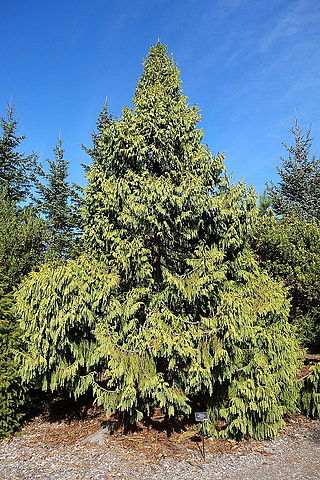
Taiwania, with the single living species Taiwania cryptomerioides, is a large coniferous tree in the cypress family Cupressaceae.

Xanthocyparis is a genus of cypresses in the family Cupressaceae. As of August 2021, it has only one species, Xanthocyparis vietnamensis, native to Vietnam and southeast China. It is commonly known as the Vietnamese golden cypress. The Nootka cypress, Cupressus nootkatensis or Callitropsis nootkatensis, was also placed in the genus, but this has been rejected.

Cupressus arizonica, the Arizona cypress, is a North American species of tree in the cypress family Cupressaceae, native to the southwestern United States and Mexico. Populations may be scattered rather than in large, dense stands.

Cupressus pygmaea, the Mendocino cypress or pygmy cypress, is a taxon of disputed status in the genus Cupressus endemic to certain coastal terraces and coastal mountain ranges of Mendocino and Sonoma Counties in northwestern California. It is a variable tree, and closely related to Cupressus abramsiana and Cupressus goveniana, enough to sometimes be considered conspecific with them.

Cupressus guadalupensis, the Guadalupe cypress, is a species of cypress from Guadalupe Island in the Pacific Ocean off western North America.

Cupressus atlantica, the Moroccan cypress, is a rare coniferous tree endemic to the valley of the Oued n'Fiss river in the High Atlas Mountains south of Marrakech in western Morocco. The majority are old, with very little regeneration due to overgrazing by goats, and they are critically endangered.
Thuja sutchuenensis, the Sichuan thuja, is a species of Thuja, an evergreen coniferous tree in the cypress family Cupressaceae. It is native to China, where it is an endangered local endemic in Chengkou County, on the southern slope of the Daba Mountains.

The Santa Cruz cypress is a species of North American tree within the Cypress family. The species is endemic to the Santa Cruz Mountains within the Santa Cruz and San Mateo counties of west-central California. The U.S. Fish and Wildlife Service listed the species on the Endangered Species Act in 1987 due to increasing threats from habitat loss and disruption of natural forest fire regimes. In 2016, the conservation status of the Santa Cruz cypress changed to Threatened. The cited reasoning was a decrease in threats against their habitat.
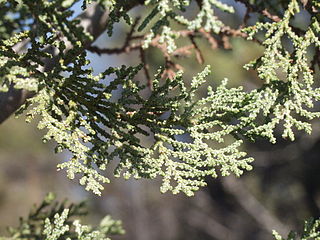
Cupressus macnabiana is a species of cypress in western North America.
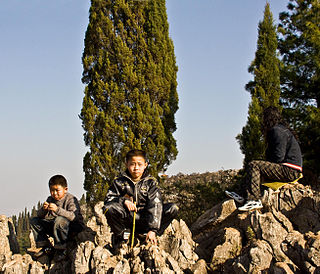
Cupressus duclouxiana, known commonly as the Chinese cypress or Yunnan cypress, is a species of conifer in the cypress family, Cupressaceae. It is endemic to China, where it is known from Yunnan and Sichuan. It grows in deep river gorges. Its habitat is mountain forest where it occurs alongside the Sikang pine and various oaks, chinquapins, and chestnuts.

Cupressus sargentii is a species of conifer in the family Cupressaceae known by the common name Sargent's cypress. It is endemic to California, where it is known from Mendocino County southwards to Santa Barbara County. This taxon is limited to the Coast Range mountains. It grows in forests with other conifers, as well as chaparral and other local mountain habitat, usually in pure stands on serpentine soils. It generally grows 10 to 15 meters tall, but it is known to exceed 22 meters. On Carson Ridge in Marin County, as well as Hood Mountain in Sonoma County, the species comprises a pygmy forest of trees which do not attain heights greater than 240–360 cm due to high mineral concentrations in the serpentine soil.

Hesperocyparis is a genus of trees in the family Cupressaceae, containing North American species otherwise assigned to the genus Cupressus. They are found throughout western North America. Only a few species have wide ranges, with most being restricted-range endemics.
The 1990 Gonghe earthquake occurred on April 26 at 17:37 China Standard Time in Hainan Tibetan Autonomous Prefecture, Qinghai Province. The mainshock had a surface wave magnitude of 7.0 Ms and a moment magnitude of 6.5 Mw . It was presaged by two foreshocks that struck merely seconds before the main earthquake. On the Mercalli intensity scale, the earthquake had a rating of IX (Violent).

Phrynocephalus vlangalii, also known as the Qinghai toad-headed agama, the Ching Hai toadhead agama, the Pylzow's toadhead agama, or gecko toadhead agama, is a species of viviparous agamid lizard endemic to the Tibetan Plateau in China. This lizard lives in burrows at high elevations of 2,000 to 4,600 meters. It is also known for its aggression, especially between females during mating season since females usually only have one mate. P. vlangalii curls its tail and shows a patch on its underbelly as defense displays against conspecifics. This lizard also has a variety of gut microbiota that help perform metabolic and biological functions depending on the altitude at which the lizard lives.


















